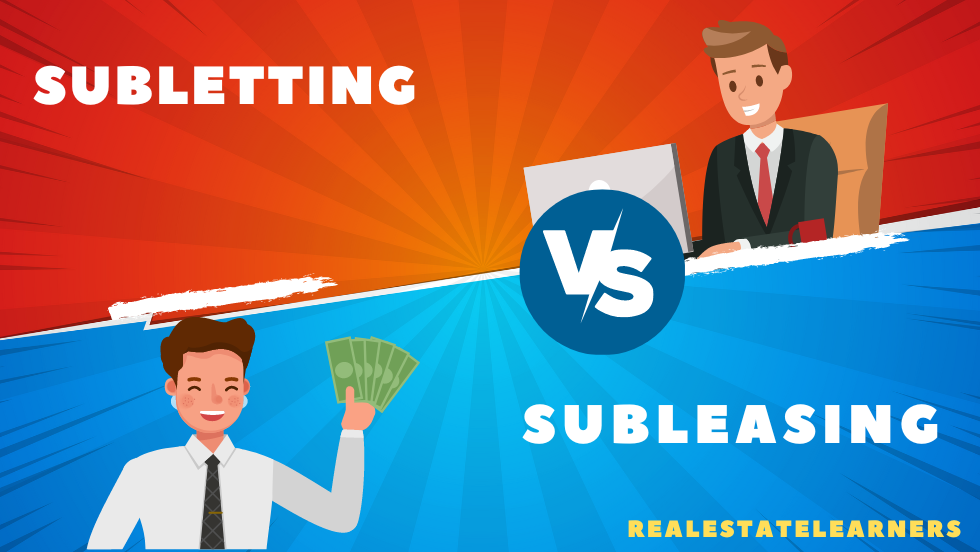Subletting and subleasing are two terms that are often used interchangeably, but they have different meanings and implications. Both involve renting out a part of a leased property to another party, but the two have key differences.
In this document, we will explore the differences between subletting and subleasing in more detail and discuss their advantages and disadvantages.
What is a Subletting?
Subletting is a rental arrangement where the original tenant of a property leases out all or part of their rented space to another individual, known as the subtenant. The new and existing tenants sign the new lease agreement with the landlord and decide the terms and conditions of the sublease.
Subletting can be a great option for tenants who need to move out of their rental space temporarily but want to keep their lease agreement and security deposit. It also benefits landlords by ensuring that the property remains occupied and rent is still paid.
What is the Example of Subletting?
Example 1
If a student must leave for the summer but has signed a one-year lease. Instead of paying for an empty apartment, they can sublet their space to another student for those few months. This way, the original tenant can keep their rental unit and continue paying rent while they are away.
Example 2
Another example would be a tenant taking an extended vacation or sabbatical and subletting their entire unit during that time to cover the rent. This allows them to return to their rental space without finding a new place or breaking their lease agreement.
Subletting can also work when multiple roommates are on a joint lease, but one has to leave for personal reasons. The remaining roommates can choose to sublet the empty room to another person as long as it is allowed in their lease agreement and approved by the landlord. Overall, subletting provides flexibility for both tenants and landlords in certain situations.
What is a Sublease?
Subleasing works by the original tenant finding a subtenant to take over all or part of their lease agreement while they are temporarily or permanently away. The sublease agreement outlines the terms and conditions the subtenant must follow, as determined by the original lease agreement. The new subtenant pays rent directly to the original tenant, who then uses that money to fulfill their lease obligations.
The original tenant is still responsible for any damages or violations of the agreement, but the subtenant may also be held accountable per their agreements with the original tenant. Subleasing provides a solution for tenants who need to move out before their lease term ends without breaking their lease or paying penalties.
What is the Example of Sublease?
Example 1
If a tenant needs to move for work or personal reasons before their lease term ends, They can find someone to sublet their rental unit and transfer their lease obligations to the new tenant. This allows them to fulfill their lease agreement without paying penalties or breaking the lease.
Example 2
Another example of subleasing could be if a student studying abroad decides to rent out their room while they are away. This allows them to continue paying for their housing without actually living there. The new tenant, in this case, the subtenant, would pay rent directly to the original tenant and follow any agreements set forth in the sublease contract.
Subleasing can also occur in commercial properties, where businesses may rent out part of their space to another business. This allows them to share the cost of rent and utilities while still maintaining their own separate leases and businesses. In any case, subleasing offers a solution for tenants who need to move out but do not want to sever ties with their rental unit.
What is the Key Difference Between Sublet vs. Sublease?
Subleasing involves transferring a lease agreement to a new tenant, while subletting is when the original tenant temporarily moves out and rents their unit to someone else.
In subleasing, the original tenant still maintains responsibility for their lease obligations, while in subletting, the temporary tenant assumes those responsibilities. Sublease agreements are typically for a specific period, while subletting is often for a shorter and more temporary period.
In subletting, the original tenant may return to their unit after the temporary period ends. In contrast, in subleasing, the original tenant may not return at all or only temporarily before permanently moving out.
Subleasing may require the landlord’s approval while subletting may only sometimes require it. The original lease agreement determines the terms and conditions of subleasing, while subletting agreements can be more flexible and negotiated between the parties involved. Breaking a sublease agreement may have stricter consequences compared to breaking a sublet agreement.
Subletting vs. subleasing can be a gray area for some, but understanding the key differences between the two is important to make informed decisions as a tenant and landlord.
What are the Advantages and Disadvantages of Sublease?
Advantages:
- Subleasing allows tenants to fulfill their lease obligations without breaking or paying penalties.
- It provides a solution for tenants needing to move out temporarily or permanently before their lease ends.
- Subleasing can help renters save money by sharing the cost of rent and utilities with the subtenant.
- It can also allow landlords to fill vacancies and avoid losing potential rental income quickly.
- Subleasing can provide flexibility for renters needing to move frequently or have changing living situations.
Disadvantages:
- Subleasing may only sometimes be allowed by the original lease agreement, so tenants must carefully review their lease terms before subletting.
- The original tenant is still responsible for any damages or violations of the lease agreement, even if caused by the subtenant.
- Subleasing can create complications and conflicts between the original tenant, subtenant, and landlord.
- Finding a suitable subtenant who meets all the requirements outlined in the sublease agreement may not be easy.
- In some cases, landlords may not approve of subleasing due to concerns about creditworthiness or the past rental history of the potential subtenant.
What are the Advantages and Disadvantages of Subletting?
Advantages:
- Subletting allows tenants to temporarily move out and rent their unit to someone else without breaking their lease.
- It can provide a temporary source of income for the original tenant while they are away.
- Subletting may be more flexible than subleasing since the parties involved can negotiate the terms and conditions.
- It can be a way for tenants to avoid paying rent on an empty unit while away.
- Subletting allows tenants to try living in a new area before committing to a long-term lease.
Disadvantages:
- Subletting may only sometimes be allowed by the original lease agreement, so tenants must carefully review their lease terms before subletting.
- The original tenant is still responsible for any damages or violations of the lease agreement during the sublet period.
- Finding a suitable temporary tenant can be challenging and time-consuming.
- There is always a risk that the temporary tenant may fail to fulfill their obligations and cause issues for the original tenant upon their return.
- Subletting without the landlord’s approval may result in penalties or legal consequences. So, it is important to always communicate with the landlord and follow the proper procedures for subletting.
- So, sublease or subletting? Both have their advantages and disadvantages, and the decision ultimately depends on the specific situation of each tenant.
Frequently Asked Questions
Is subleasing legal?
Subleasing is generally legal as long as it is allowed by the original lease agreement and all parties involved follow proper procedures.
Can I make changes to the sublease agreement?
Yes, sublease agreements can be negotiated and modified between the original tenant and subtenant, but both parties must agree upon any changes.
What happens if the subtenant damages the unit?
The original tenant is responsible for any damages caused by the subtenant during the sublease period.
Do I need my landlord’s approval to sublet?
It depends on the terms of your lease agreement, but it is typically recommended to inform and receive approval from your landlord before subletting.
Conclusion
Subletting and subleasing can be helpful options for tenants who need to temporarily move out or want to rent their unit while they are away. However, it is important for all parties involved to carefully review the lease agreement and follow proper procedures to avoid any conflicts or legal consequences. Communication with the landlord is always key when considering subletting or subleasing.
Sublease vs. sublet could be confusing for many tenants, but understanding the differences can help make informed decisions. Both options have their advantages and disadvantages, so it is important to carefully evaluate your situation before deciding which option is best for you.

Corey has over 15 years of experience as a real estate broker and educator. He is dedicated to providing valuable insights and guidance for those looking to enter the real estate industry.

